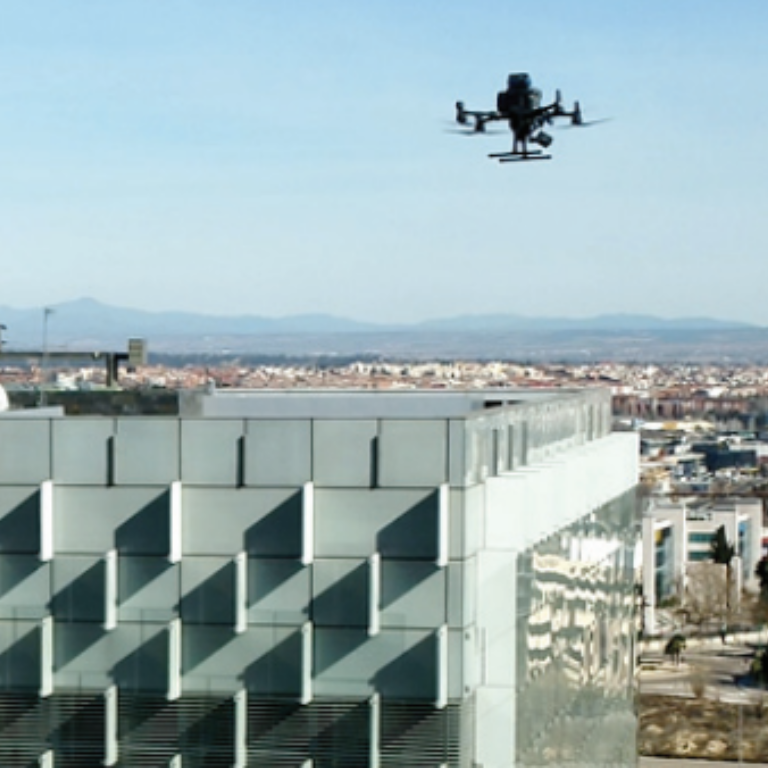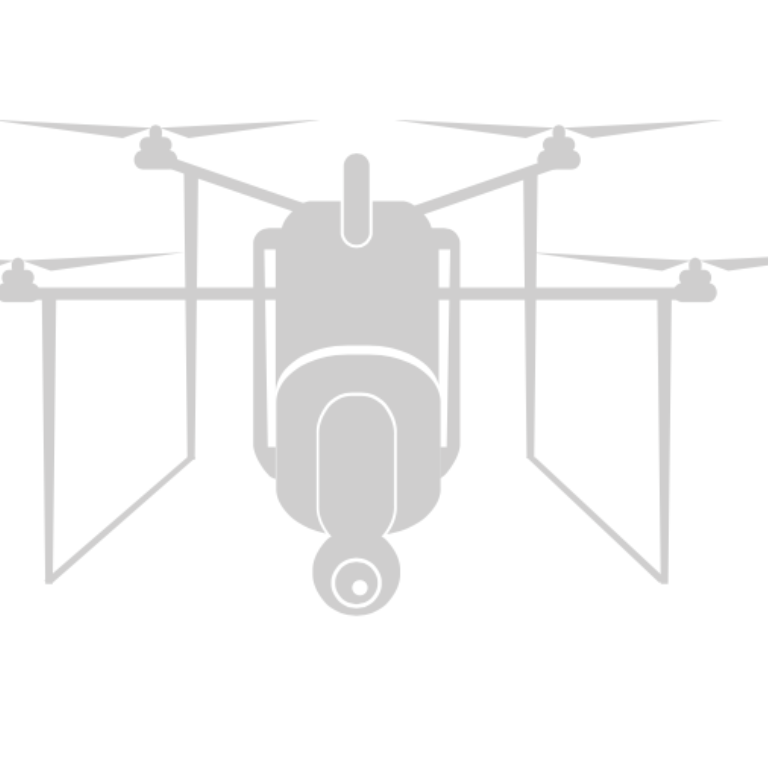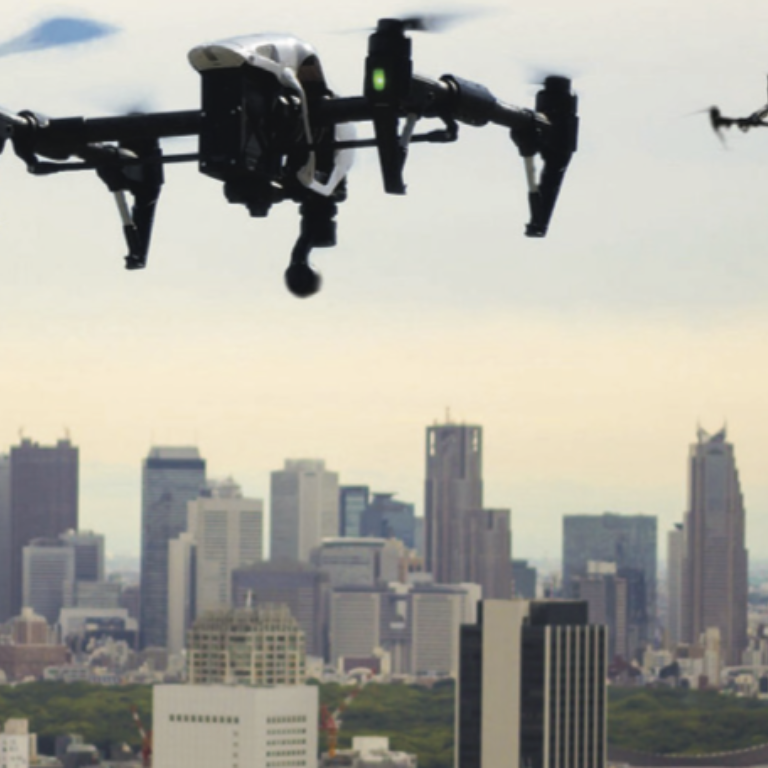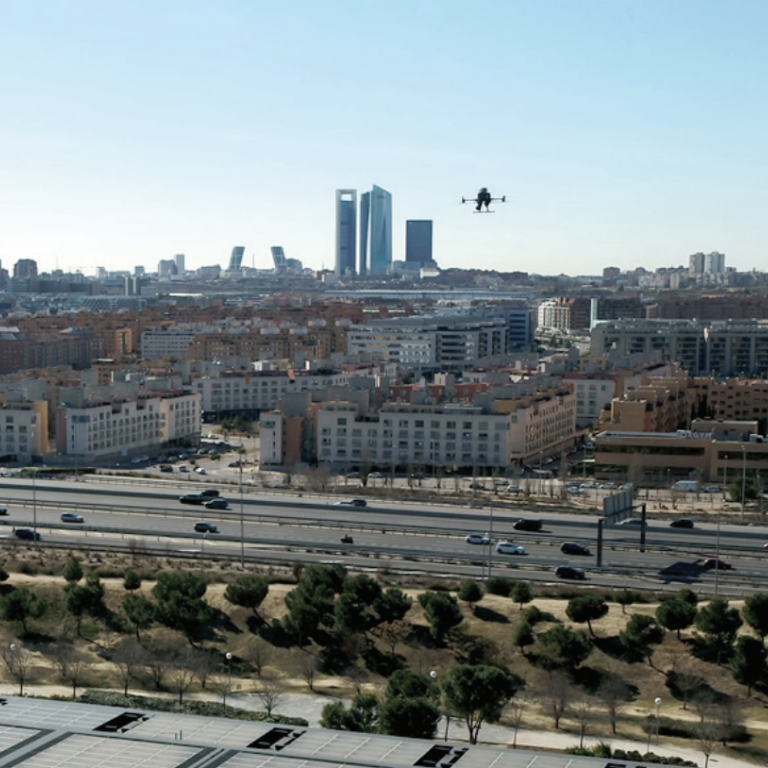5G Transformation Hub
How 5G can enable drones to perform key tasks
Surveillance drones could be up to 15 times more efficient than a fixed camera
Telefónica and tech partner Unmanned Life are testing and demonstrating how 5G-connected drones can support surveillance at the telco’s headquarters in Las Tablas, in the north of Madrid. The footage from the drones’ onboard cameras can be streamed via 5G to edge computing facilities, where the images can be analysed by software that can immediately identify anomalies.
Select a project
Contents
Challenge
Existing surveillance tools, such as CCTV, are constrained by fixed angles and limited range. These limitations can mean false call outs, which are labour intensive and can be error prone. In cases where helicopters are used for surveillance, there is the risk of an accident and injury to the crew, as well as the expense involved in flying such a large aircraft. It can cost more than €1,000 an hour to keep a helicopter in the air.
Solution
Telefónica and Unmanned Life are flying multiple 5G-connected drones on surveillance missions several times a week. The drones autonomously calculate the route in real-time using a 5G connection to an edge compute facility. Once the mission is underway, high-quality video is streamed via 5G to Telefónica’s security centre. A person recognition system, developed with artificial intelligence, automatically spots any unauthorised entry to the site.
Impact & Statistics
Given the high cost of manual surveillance, drones could cut costs dramatically by providing a flexible and efficient means of surveying large areas and detecting problems. Telefónica estimates drones could be up to 15 times more efficient than a fixed camera, while also speeding up response times 80-fold in unattended environments.
Wider Implications
Connected drones could be used in a wide range of scenarios from routine security checks to monitoring crowds to surveying the aftermath of a natural disaster. Telefónica says the solution it is testing is already attracting interest from analytical companies, sports clubs, the military and police. The mobile operator believes the technology could ultimately be deployed across smart port environments, heavy industry sites, smart factories, agricultural monitoring, and other sectors for security, surveillance, event verification, or critical infrastructure maintenance tasks.
Stakeholders
Telefónica and tech company Unmanned Life
02
How 5G can Enable Drones to Perform Key Tasks
Surveillance drones could be up to 15 times more efficient than a fixed camera
Equipped with video cameras, drones can quickly and efficiently survey property and land, detecting damage and potential security breaches. Using 5G networks, the footage from these cameras can be streamed to edge computing facilities, where the images can be analysed by software that can immediately identify anomalies.
Telefónica and tech partner Unmanned Life are testing and demonstrating 5G-connected drones for surveillance purposes at the telco’s headquarters in Las Tablas, in the north of Madrid. The complex, which holds 14,000 people, is a challenging testing ground for drone technology. Located in a busy air space area, the headquarters is close to Madrid Airport, Madrid’s metropolitan area, and two heliports. The trial requires intensive coordination and communication with AESA (the Spanish Aviation Safety Agency).
Telefónica is exploring two different kinds of surveillance missions, each involving at least two drones working together. The first is routine surveillance, in which an operator sets a required interval, as well as the number of drones, to survey preconfigured areas. The second is on-demand drone flights: In this case, the operator will select the drones and indicate the required area for each flight.
In both cases, the drones autonomously calculate the route in real-time using a 5G connection to an edge compute facility. Once the mission is underway, high-quality video is streamed in real-time to Telefónica’s security centre via 5G. A person detection system, developed with artificial intelligence, automatically spots any unauthorised entry to the site.
Telefónica has also found the drones to be useful for other purposes. “We had a sand storm here in Madrid and with the drones we were able to inspect the sand covering the solar panels on our roof,” recalls Miguel Álvaro a drone specialist from Telefónica Ingeniería de Seguridad.
Since the trials began in December 2021, Telefónica has been conducting two or three drone missions per week, depending on the weather conditions. The trials have helped Telefónica and Unmanned Life refine the solution. “Two or three times, we have augmented and upgraded functionalities of the platform,” notes Kim Clement, CTO of Unmanned Life.
Each drone can fly for 45 minutes before autonomously visiting a nearby charging station to fully recharge in about 30 minutes. The system has been designed to comply with all aeronautical legal requirements for drone flight and privacy.
Although regulations require the flights to be overseen by a reserve pilot, the drones fly completely autonomously and the pilot hasn’t yet had to intervene. Telefónica hopes to secure regulatory clearance to remove the pilot oversight by the end of 2022.


Miguel Álvaro
Drone specialist from Telefónica Ingeniería de Seguridad
03
Drones can be much more cost-effective than alternatives
Telefónica says connected drones can be much more effective than existing surveillance tools, such as CCTV, which are constrained by fixed angles and limited range. These limitations can mean false call outs, which are labour intensive and can be error prone. In cases where helicopters are used for surveillance, there is the risk of an accident and injury to the crew, as well as the expense involved in flying such a large aircraft. It can cost more than €1,000 an hour to keep a helicopter in the air.
Given the high cost of manual surveillance, drones could cut costs dramatically by providing a flexible and efficient means of surveying large areas and detecting problems. Telefónica estimates drones could be up to 15 times more efficient than a fixed camera, while also speeding up response times 80-fold in unattended environments.
Telefónica says its connected drones are attracting interest from analytical companies, sports clubs, the military and police. “When we make the business case, our focus is for the security, but we know that the drones can be used for more than this aspect,” says Miguel Álvaro Fernández “Every day, we note new functionalities that the drone service can do, as customers suggest more functionalities that we don’t have in our road map.”
By locating the computational power required for image recognition at the edge of the network, Unmanned Life is able to reduce the weight of the drone and increase flight times. The longer each surveillance mission, the greater the overall efficiency. Using computing power at the edge, rather than in the cloud, also delivers the low latency required to ensure the analytics are presented in real-time.
Unmanned Life also uses the edge compute to perform the real-time calculations required to enable a swarm of drones to fly autonomously. With a low latency connection, the drones are able to react rapidly to any change in the circumstances.
The trials harnessed both on-site edge devices and the public network telco edge. As the solution is deployed commercially, Telefónica plans to use the public network telco edge capabilities within its 5G network to support the drones. That means it can offer the whole solution as a service, rather than a project or a product.
“For example, if we want to deploy the system in Bilbao or another city in Spain, we don’t need to go there with our server to deploy all the system,” explains Miguel Álvaro. “We only need to deploy the service in an existing edge facility.” However, Telefónica recognises that some customers, such as the military, may prefer to use private computing facilities.
Unmanned Life’s platform is designed to be hardware-agnostic, so it can support a wide range of drones, including models with rotors and fixed-wing aircraft with a much longer flight time. When the battery of one drone is running low, the platform automatically replaces it with a fully-charged model.

04
5G supports better video and more drones
Telefónica’s 5G network is a crucial part of the overall solution. It can transmit data at high bandwidth and capacity, whilst supporting the low latency required for drones to communicate in real-time. In the past, drones have used proprietary wireless communications systems to enable a pilot to control them remotely. The limitations of these systems mean the drones need to fly within visual line of sight and can only transmit low quality video streams.
The capacity of 5G means “we can increase the throughput for the video, if we want,” as well as using multiple drones, explains Miguel Álvaro. Although “we are able to control the drone and video with 4G technology, if we want to control a swarm of drones, 5G is important.”
As well as providing faster, more responsive connectivity, the 5G public network makes it easier to scale the solution. Where cellular coverage is already in place, connected drones can be configured quickly using dedicated access point names (APN).
Telefónica’s trials of drone technology are yielding some important insights as to how 5G deployments could evolve to support drones. It has found that existing cellular networks, which have been optimised to support land-based devices, such as smartphones, won’t necessarily perform as well when serving airborne devices, such as drones.
“We need to be very careful with the protocols that we use to, for instance, to stream video to the edge in order to recognise images,” says David Moro, head of services platform in Telefónica CTIO. “In the upcoming years, we know that drones are going to be increasing in number. So, we need to start thinking about how to optimise for the needs of this specific kind of end user, the specific terminals that we are going to have.”
Working with Unmanned Life, Telefónica is already optimising the way in which videos are transmitted. Although forthcoming iterations of the 5G standard will incorporate specific features to support drones, telcos will also need to consider how to support airborne connections when planning their coverage. “We are now going to have devices or terminals that are flying at 60 metres when this is not normally the case,” says David Moro. “It’s a way of thinking. In the past, the planners of the access network didn’t traditionally think about having to support drones. But this is something we need to take into consideration for the following years and it’s a very important insight.”
As their numbers rise, drones will need to communicate with air traffic systems. In this respect, customised 5G connectivity is set to play a key role in enabling individual drones to connect directly with UAM (urban air mobility) systems and with each other. Through this low latency, managed connectivity, the drones will be able to communicate their coordinates, their altitude, their direction of travel and speed in real-time. “Now that we are enabling swarms of drones, all of them need to be coordinated to avoid risk,” notes Kim Clement.


David Moro
Head of services platform in Telefónica CTIO
05
Next steps – getting customers comfortable with the technology
Telefónica is hopeful that the first commercial deployments of its drone surveillance solution will begin during 2022. “The technology is very new, so customers are unfamiliar with it and they are a little bit reticent to implement it,” says Miguel Álvaro. “But I think the first reference customer will be a good opportunity to increase the deployment.”
The mobile operator believes the solution could ultimately be deployed across smart port environments, heavy industry sites, smart factories, agricultural monitoring, and other sectors for security, surveillance, event verification, or critical infrastructure maintenance tasks.
Together a drone, a video camera and image recognition software are a potent combination that could be used across many different use cases. “We consider the drone as a tool,” explains Miguel Álvaro. “The most important part for us is the camera, the video, that give us a view of the perimeter that we want to analyse.”
From a cost perspective, another key step will be the green light from regulators to allow fully autonomous flights (without a pilot in reserve). The trials being conducted by Telefónica could pave the way for regulatory clearance in Spain during 2022.
“One of the most important things for Telefónica is that we have very good vision of the regulatory parts,” says Miguel Álvaro. “And we know really what it is possible to do and not to do with the drones at this moment and what will be possible to do in the following months or years. And with this vision, we can deploy products in the market, not only proof of concepts and so on.”


Miguel Álvaro
Drone specialist from Telefónica Ingeniería de Seguridad
07
About
About the GSMA
The GSMA is a global organisation unifying the mobile ecosystem to discover, develop and deliver innovation foundational to positive business environments and societal change. Our vision is to unlock the full power of connectivity so that people,
industry, and society thrive. Representing mobile operators and organisations across the mobile ecosystem and adjacent industries, the GSMA delivers for its members across three broad pillars: Connectivity for Good, Industry Services and Solutions, and Outreach. This activity includes advancing policy, tackling today’s biggest societal challenges, underpinning the technology and interoperability that make mobile work, and providing the world’s largest platform to convene the mobile ecosystem at the MWC and M360 series of events.
For more information, please visit the GSMA corporate website at www.gsma.com.
Follow the GSMA on Twitter: @GSMA.
GSMA 5G Transformation Hub
The GSMA 5G Transformation Hub is a source of information on some of the most innovative 5G solutions in the world. This portal contains case studies detailing design, benefits, key players, measured value and the future impact of scaling up these 5G solutions worldwide. The 5G Era is now firmly established and this family of standardised GSM technologies, including mmWave, are being rolled out successfully across the globe. The GSMA 5G Transformation Hub, launched at MWC Barcelona in 2022, provides details of how 5G is best placed to deliver real value for a range of key sectors including manufacturing, energy, transportation, media and live entertainment, smart cities and construction.. Many more case studies will be added, in the coming months, covering even more industries and the GSMA is asking Members to nominate innovative 5G case studies to add to this global digital showcase. The 5G Transformation Hub and this particular Case Study are both sponsored by Qualcomm.
About this case study
This case study is for information only and is provided as is. The GSM Association makes no representations and gives no warranties or undertakings (express or implied) with respect to the study and does not accept any responsibility for , and hereby disclaims any liability for the accuracy or completeness or timeliness of the information contained in this document. Any use of the study is at the users own risk and the user assumes liability for any third party claims associated with such use.